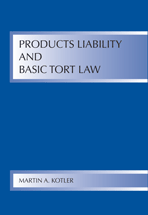Products Liability and Basic Tort Law is primarily intended as a supplement to whatever casebook is adopted in a law school Products Liability course. Law teachers using a case discussion method find that this invariably leaves numerous gaps in the material covered. Additionally, many students need to have the material organized in a narrative format. This book is intended to fill in the gaps, provide greater depth to the materials normally covered in class, and expand upon those materials by presenting subjects that cannot be assigned for class discussion given the inevitable time constraints. The book covers all products liability theories; express and implied warranty under the Uniform Commercial Code; fraudulent, negligent and innocent misrepresentation; strict liability and, of course, negligence.
Because the book places products liability law into the larger context of tort law, large sections are devoted to basic tort principles of duty, actual and proximate cause, damages, defenses and third party claims for indemnity and contribution. As a result, the book would also be an excellent supplement to whatever casebook is being used in a traditional first-year law school torts class.
In order to make it more useful to students, the author has included for discussion and illustration purposes the classic products and tort cases contained in many of the major products liability and torts casebooks. Even when those cases could not be discussed in the text, he has included many in the notes, creating a table of cases that serves as a useful index for students.
In addition to tracing the development of modern products liability and tort doctrine, the book discusses and analyzes many of the currently hot issues in products liability law and tort law, not only clarifying the underlying issues, but, in many instances, showing where and why recent lines of cases and developing doctrine fit in or, more commonly, fail to fit in to traditional legal concepts and traditional understanding about the respective roles of judges, juries and legislatures. For example, the current push to carve out separate spheres for tort and contract law and the resulting incoherence of doctrine is a recurring theme as is the (largely political) impetus for tort and products liability reform in the courts, state legislatures and Congress. The explanation and criticism of some emerging doctrine should provide practitioners with a valuable basis for structuring a legal argument in an appropriate case.
This book is also available in cloth binding.


